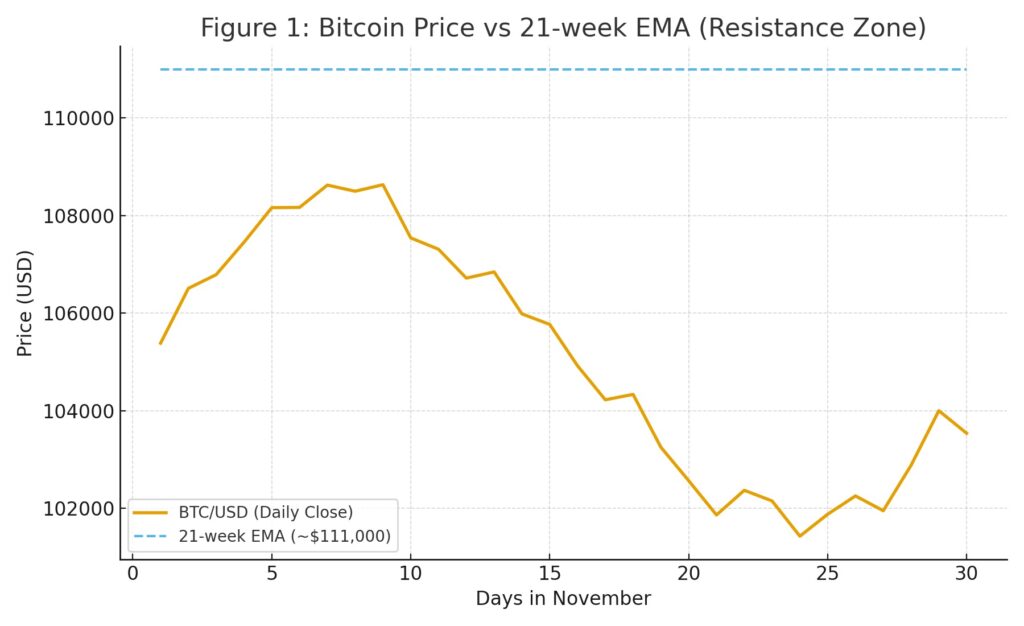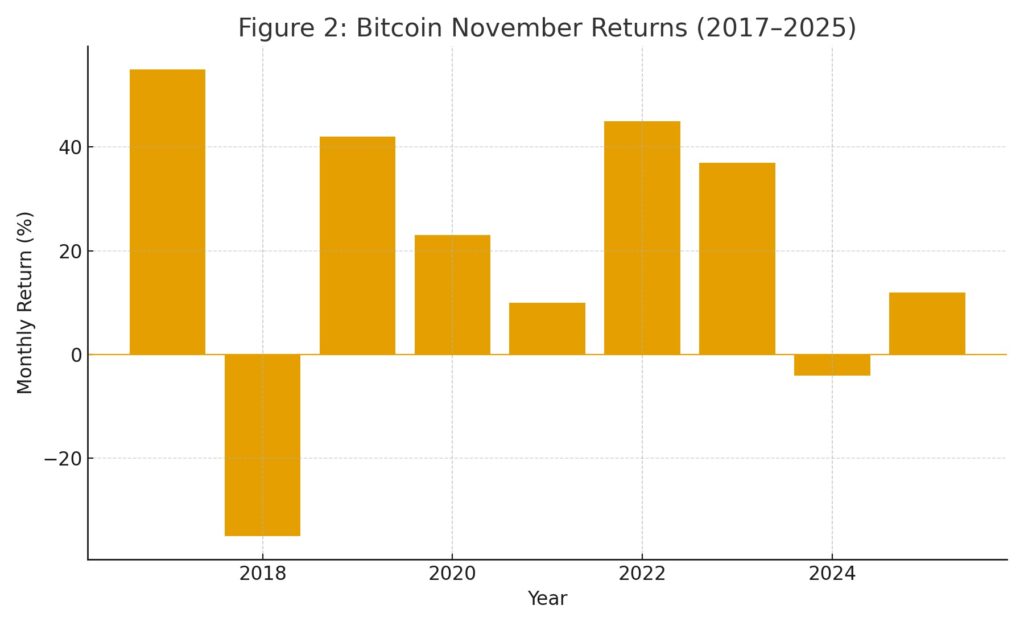
Main Points :
- Bitcoin (BTC) reached a November high of approximately $111,000, marking its first return above six figures in the month.
- Despite the price surge, key resistance around roughly $112,000 (including the 21-week Exponential Moving Average (EMA)) remains unbroken, raising concern among traders about sustainability.
- Increased sell pressure from large holders (so-called “whales”) and persistent macroeconomic headwinds (e.g., hawkish central bank signals) are darkening the bullish narrative.
- On-chain and technical indicators suggest that $104,000-$108,000 may serve as important floors; a decisive break below those could weaken the bull case.
- For new asset seekers and blockchain-use-case advocates, the current environment offers both risk and opportunity: accumulation zones may open, but timing and composure matter more than ever.
1. The Recent Price Surge and What It Means
In early November, Bitcoin surged to a local high around $111,129 on major exchanges such as Bitstamp, marking the month’s first return above the six-figure threshold. The move was partially driven by accelerated buying on prominent platforms such as Coinbase and Binance, which signalled renewed bidder interest.
For investors hunting new crypto assets or exploring blockchain applications, this kind of breakout moment generates excitement: the “digital gold” narrative of Bitcoin regaining traction evokes talk of next-leg upside. However, the story is deeply nuanced. The uptick occurred under the shadow of macro fragility (liquidations, profit-taking) and the market’s well-documented susceptibility to “weekend pumps” that reverse once weekday trading resumes. Indeed, one trader flagged that “another Sunday pump, and we know how this ends.”
That suggests caution: momentum alone does not always translate to sustainability, especially when broader conditions (regulatory, institutional flows, macro) are shaky.

2. Resistance at $112,000 and the 21-Week EMA Challenge
One of the central technical hurdles for Bitcoin’s next leg up is reclaiming the 21-week EMA — a widely followed metric among crypto analysts and traders. At the time of the latest move, that level hovered around $111,230. Analyst Rekt Capital warned that until Bitcoin “successfully post-breakout retests” the 21-week EMA, the upward trend cannot be fully trusted.
Overlaying this, the threshold of approximately $112,000 serves as another psychological and structural barrier: bullish participants believe that flipping $112k from resistance into support would materially strengthen the uptrend. However, the market has yet to achieve that. This leaves Bitcoin at risk of short-term reversal even though price action appears bullish.
In practical terms for those scouting new crypto assets or blockchain-infrastructure plays: if Bitcoin cannot break through and hold that zone, attention may rotate out of top-cap assets into alternative chains or tokens with steadily accumulating fundamentals.
3. On-Chain Signals, Whales & Distribution Pressures
Beyond pure price charts, on-chain data are signalling subtle but meaningful shifts. One notable development: a whale wallet reportedly resumed distributing roughly $650 million in BTC after a prior-cycle top. This suggests that large holders may be taking profits or rotating into other assets, which increases risk of future supply pressure.
Simultaneously, the increasing correlation between Bitcoin and major equity-indices such as the Nasdaq 100 is another red flag. Recent data show Bitcoin’s correlation approaching 0.88 with the Nasdaq — its highest since June — indicating that when risk-off sentiment hits the equities market, crypto will likely follow.
On-chain and investor-flow analysis (see study by Maerki Baumann & Co.) indicate Bitcoin is behaving more like a risk-on tool than a true “safe haven”.
For investors eyeing emerging tokens: one takeaway is to monitor where capital is flowing away from Bitcoin. Distribution from whales often precedes rotation into altcoins or emerging infrastructure plays — which could be your window.
4. Macro Backdrop: Liquidity, Central Banks & Seasonal Patterns
Even the strongest technical setups are vulnerable if the macro environment turns hostile. Multiple sources highlight how Bitcoin’s fate remains intertwined with broader financial market dynamics. For instance, a hawkish posture from the Federal Reserve chair eroded expectations of a December rate cut, which weighed on risk assets broadly — including BTC.
October was notably weak for Bitcoin (down ~4 %), marking the first monthly decline since 2018 for the “Uptober” month. Furthermore, historical patterns suggest November can be strong for Bitcoin (average gain ~42 %) — but the setup this year is more nuanced given liquidations (~$19 billion in long positions) and tight liquidity.
For practitioners working with blockchain-enabled businesses or institutional adoption strategies, the macro signals matter: the degree of institutional interest, ETF flows, and regulatory clarity will influence when and how blockchain innovations gain traction — not just retail sentiment.

5. Key Levels to Watch: Floors, Ceilings and Strategy
From both technical and fundamental vantage points, several levels stand out:
- Support/floor: ~$104,000–$108,000 zone is emerging as a battery-acid test. A sustained break below ~$100,000 could invite deeper correction.
- Resistance/ceiling: ~$112,000 (21-week EMA) primarily, and secondary barrier ~$114,000–$115,000. If Bitcoin breaks above and holds those levels, the next target could approach ~$120,000.
- Risk scenario: If macro liquidity tightens further or ETF flows reverse, Bitcoin may retest the lower support zones and the altcoin space might move faster.
- Opportunity scenario: If Bitcoin flips the $112k zone into support, then the “renewed bull” narrative may accelerate and new crypto assets/DeFi layers could benefit from rotation.
For your audience — those exploring new crypto assets, revenue-generation, and applied blockchain use cases: the current range strategy makes sense. Waiting for a clear breakout or buying selectively into blockchain infrastructure plays while monitoring Bitcoin’s behaviour might be the optimal path.
6. Implications for New Crypto Assets & Blockchain Use-Cases
Given the context, how should someone looking for the next crypto asset or deployment opportunity think about it?
- Rotate away from pure direction-bet on Bitcoin, unless your timeframe is very long and you accept considerable volatility.
- Focus on infrastructure tokens (Layer-1, Layer-2s, interoperable bridges) that may benefit from either a breakout or consolidation phase.
- Watch ETF and institutional flows, as capital leaving or entering Bitcoin may signal where next-wave interest travels (e.g., alternative chains or real-world-asset tokens).
- For practitioners building blockchain products: If Bitcoin remains range-bound, user adoption may pivot toward ecosystem growth (wallets, swaps, DeFi) rather than purely price-driven speculation. That means practical deployments (non-custodial wallets, swaps, DeFi primitives) grow in importance.
- Use the current range as a ‘calm before breakout’. Periods of consolidation often provide iterative innovation windows. If you are developing a blockchain solution (for example your non-custodial “dzilla Wallet” or swap UX), this is the time to refine UX, integration, marketing and build momentum ahead of next surge.
7. Conclusion
Bitcoin’s climb to about $111,000 is both encouraging and cautionary. The price move signals renewed interest, but without breaking and holding key resistance (especially ~$112,000 and the 21-week EMA) the risk of a false breakout remains meaningful. Macro factors — whale behaviour, ETF flows, central-bank policy — are playing a heavier role than many appreciate.
For those in search of new crypto assets, or building blockchain-based revenue models, the current landscape offers a two-pronged scenario:
- Risk: Bitcoin fails to hold breakout and declines into $100k zone, which may tighten liquidity and push altcoins into the shadows temporarily.
- Opportunity: Bitcoin succeeds in flipping resistance to support, which could unlock rotation into emerging tokens and catalyse real-world blockchain application growth.
Therefore the most prudent approach is strategic patience: define entry levels, watch key levels (~$104-108 k support, ~$112 k resistance) and concurrently invest in fundamentals — whether that is token projects, wallet infrastructure, or blockchain apps. Ultimately, the story for blockchain and crypto doesn’t hinge solely on Bitcoin’s next leg—it depends on real-world use and adoption scaling up now when prices may be offering sympathetic entry points.

